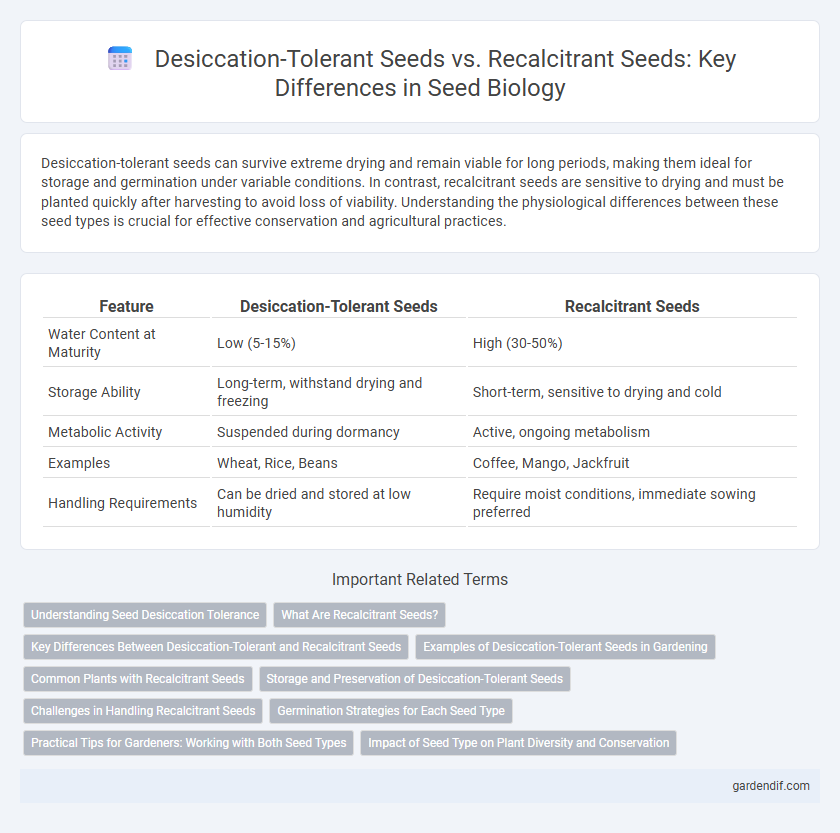
Desiccation-tolerant seeds vs Recalcitrant seeds Illustration
Desiccation-tolerant seeds can survive extreme drying and remain viable for long periods, making them ideal for storage and germination under variable conditions. In contrast, recalcitrant seeds are sensitive to drying and must be planted quickly after harvesting to avoid loss of viability. Understanding the physiological differences between these seed types is crucial for effective conservation and agricultural practices.
Table of Comparison
| Feature | Desiccation-Tolerant Seeds | Recalcitrant Seeds |
|---|---|---|
| Water Content at Maturity | Low (5-15%) | High (30-50%) |
| Storage Ability | Long-term, withstand drying and freezing | Short-term, sensitive to drying and cold |
| Metabolic Activity | Suspended during dormancy | Active, ongoing metabolism |
| Examples | Wheat, Rice, Beans | Coffee, Mango, Jackfruit |
| Handling Requirements | Can be dried and stored at low humidity | Require moist conditions, immediate sowing preferred |
Understanding Seed Desiccation Tolerance
Seed desiccation tolerance enables certain seeds to survive extreme dehydration, maintaining viability during storage and adverse environmental conditions. Desiccation-tolerant seeds, typically orthodox seeds, undergo metabolic shutdown and accumulate protective molecules like late embryogenesis abundant (LEA) proteins and sugars such as trehalose that stabilize cellular structures. In contrast, recalcitrant seeds lack such protective mechanisms, remain metabolically active, and are highly sensitive to drying, requiring immediate germination or moist storage to prevent viability loss.
What Are Recalcitrant Seeds?
Recalcitrant seeds are characterized by their inability to withstand drying and low temperatures, making them sensitive to desiccation and challenging to store long-term. These seeds maintain high moisture content after maturity and rapidly lose viability when exposed to drying conditions, contrasting with desiccation-tolerant seeds that can survive drying. Examples include seeds from tropical plants like mango, avocado, and cacao, which require immediate sowing to ensure germination success.
Key Differences Between Desiccation-Tolerant and Recalcitrant Seeds
Desiccation-tolerant seeds can survive extreme drying, maintaining viability through low moisture levels, while recalcitrant seeds are sensitive to desiccation and lose viability when dried. Desiccation-tolerant seeds often enter a dormant state, enabling long-term storage and dispersal, whereas recalcitrant seeds require immediate germination in moist conditions. These fundamental physiological differences influence seed storage behavior, conservation strategies, and species distribution.
Examples of Desiccation-Tolerant Seeds in Gardening
Desiccation-tolerant seeds, commonly used in gardening, include species such as beans (Phaseolus spp.), peas (Pisum sativum), and sunflowers (Helianthus annuus), which can survive drying and remain viable for extended periods. These orthodox seeds withstand moisture loss without damage, facilitating long-term storage in seed banks and home seed collections. Their resilience contrasts with recalcitrant seeds like avocados (Persea americana), which require high moisture and cannot endure drying.
Common Plants with Recalcitrant Seeds
Recalcitrant seeds, which are sensitive to drying and cannot survive desiccation, are commonly found in tropical and subtropical plants such as mango (Mangifera indica), coconut (Cocos nucifera), and jackfruit (Artocarpus heterophyllus). These seeds maintain high moisture content and are metabolically active, requiring immediate sowing after harvest to ensure viability. Their desiccation intolerance contrasts with desiccation-tolerant orthodox seeds typical of temperate species, influencing storage and propagation strategies.
Storage and Preservation of Desiccation-Tolerant Seeds
Desiccation-tolerant seeds can survive extreme drying and are ideal for long-term storage in seed banks due to their low moisture content and metabolic dormancy. These seeds maintain viability for years when stored at low temperatures and controlled humidity, enabling effective preservation of genetic diversity. In contrast, recalcitrant seeds cannot withstand drying and require alternative conservation strategies such as cryopreservation or in vitro culture.
Challenges in Handling Recalcitrant Seeds
Recalcitrant seeds exhibit high moisture content and sensitivity to drying, making storage and transport challenging compared to desiccation-tolerant seeds that can survive drying. Their inability to withstand dehydration limits the use of conventional seed storage methods, leading to significant viability loss during handling. Developing specialized preservation techniques, such as cryopreservation and controlled environment storage, is critical to maintaining the viability of recalcitrant seeds.
Germination Strategies for Each Seed Type
Desiccation-tolerant seeds withstand drying and remain viable for extended periods, enabling delayed germination until favorable moisture conditions arise. In contrast, recalcitrant seeds lack drying resistance and must germinate rapidly post-dispersal to prevent viability loss. Understanding these germination strategies aids in optimizing seed storage, conservation, and agricultural practices for different plant species.
Practical Tips for Gardeners: Working with Both Seed Types
Desiccation-tolerant seeds can be stored for long periods in dry conditions, making them ideal for traditional seed saving and easy germination when planted. Recalcitrant seeds require immediate planting and moist storage to maintain viability, as drying rapidly reduces their ability to sprout. Gardeners should label seed types clearly and adjust storage methods accordingly, using silica gel or airtight containers for desiccation-tolerant seeds and refrigeration with high humidity for recalcitrant seeds.
Impact of Seed Type on Plant Diversity and Conservation
Desiccation-tolerant seeds can survive drying and storage, enabling effective seed banking and long-term conservation, which supports the preservation of plant diversity. In contrast, recalcitrant seeds are sensitive to desiccation and cannot be stored easily, posing significant challenges to ex situ conservation efforts and requiring alternative strategies such as cryopreservation. The differential handling requirements of these seed types directly influence biodiversity maintenance and restoration programs, affecting global conservation priorities.
Desiccation-tolerant seeds vs Recalcitrant seeds Infographic

 gardendif.com
gardendif.com